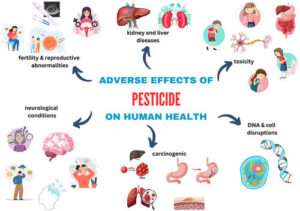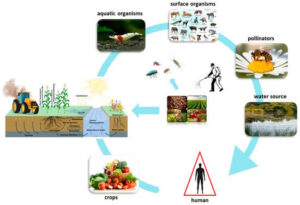Back to: Environmental Biology 400 Level
Welcome to class!
Have you ever noticed a sudden drop in the number of butterflies or bees around farmlands after crops have been sprayed? Or perhaps you’ve seen fish floating lifeless in a nearby stream after the rainy season washes farm chemicals into water bodies? These are real signs of pesticide and herbicide toxicity at work. Today’s lesson will help you understand what these chemicals are, how they work, their risks, and how we can use them more responsibly.
Pesticide And Herbicide Toxicology
What Are Pesticides and Herbicides?
Pesticides are chemicals used to kill pests like insects, rodents, or fungi that damage crops and stored food. Herbicides are a type of pesticide designed specifically to kill or inhibit the growth of unwanted plants (weeds).

In Nigeria, common examples include:
Pesticides like DDT, Lindane, and Chlorpyrifos
Herbicides like Paraquat, Glyphosate (widely used in cassava and maize farms)
Why Are They Used in Agriculture?
Farmers use these chemicals to:
Increase crop yield by protecting plants from pests and weeds
Reduce labour and cost of manual weeding
Improve food security and economic profit
Toxicological Concerns
The problem arises when these chemicals affect more than their intended targets. Many pesticides and herbicides are toxic to humans, animals, and beneficial insects.
They can enter the body through:
Inhalation (spraying without protective masks)
Skin contact (bare hands during application)

Ingestion (eating crops with chemical residue)
Health Effects of Pesticide and Herbicide Exposure
Short-term (acute) effects: headaches, dizziness, nausea, skin rashes, eye irritation
Long-term (chronic) effects: cancer, neurological damage, infertility, and hormonal disruption
Increased risk of birth defects in children exposed through mothers during pregnancy
Environmental Effects
Killing of non-target species like bees and butterflies, affecting pollination
Contamination of rivers and lakes, leading to fish kills and water toxicity
Soil degradation and loss of biodiversity
Disruption of food chains and ecological balance
Case Study: Farming in Benue and Kano States
In these major agricultural zones, excessive use of herbicides to control weeds in rice and maize farms has led to reduced soil fertility and local water contamination. Health complaints among farmers—such as skin irritation and chest pain—have been reported after repeated exposure.
Safe Practices and Alternatives
Use of Personal Protective Equipment (PPE) during application
Applying chemicals in recommended doses and times

Washing fruits and vegetables thoroughly before consumption
Promoting Integrated Pest Management (IPM): using biological control (e.g. neem oil), crop rotation, and organic alternatives
Training farmers and agro-dealers on safe chemical handling and storage
Summary
- Pesticides kill pests, while herbicides target weeds.
- They are widely used in Nigerian agriculture to boost crop production.
- Exposure to these chemicals can cause serious health and environmental problems.
- Improper use leads to soil degradation, water pollution, and ecosystem damage.
- Safe application, protective gear, and integrated pest management are essential solutions.
Evaluation
- Differentiate between pesticides and herbicides.
- Mention two health effects of long-term pesticide exposure.
- What is one environmental effect of herbicide overuse?
- Suggest two safety practices for pesticide application.
- Explain what Integrated Pest Management means and give one example.
You’re making amazing progress! Understanding pesticide and herbicide toxicology equips you to protect lives, crops, and ecosystems. Keep shining—Afrilearn is right here with you on the path to becoming an environmental champion!
